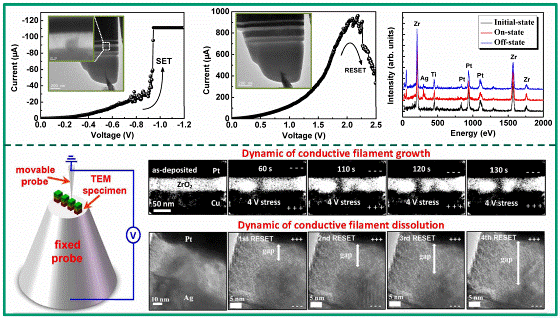A series of progress has been made in the research of micro-mechanism of resistive memory in microelectronics
A few days ago, the Laboratory of Nanomachining and New Device Integration Technology (Three Chambers) of the Institute of Microelectronics of the Chinese Academy of Sciences made a series of progress in the research of the micromechanism of resistive memory. Resistive random access memory (RRAM) has the advantages of simple structure, high speed, low power consumption, and easy 3D integration. It is one of the strong competitors of the next generation of high-density non-volatile memory. However, the unclear resistance mechanism hinders the rapid development of RRAM. Discussing and studying the microscopic physical mechanism of RRAM from the most basic microscopic level, obtaining the internal relationship between the electrical characteristics of RRAM and the microstructure of the material, has an important guiding role in controlling and improving the storage characteristics of the device, and also helps in the device failure model Establishment and analysis. However, how to obtain the microstructure change information accompanying the resistive change process through microscopic characterization has always been a difficult problem that needs to be solved urgently in experimental technology and scheme design. The research group led by Researcher Liu Ming of the Institute of Microelectronics has carried out systematic research work on device performance optimization, integration technology and resistance change mechanism for binary metal oxide-based RRAM with good CMOS process compatibility, and has achieved some important progress. For the study of the resistance change mechanism, the research team used ZrO2 as a template to analyze the temperature change of the high and low resistance states of the Cu / ZrO2 / Pt device and found that the temperature coefficient of the device and the temperature of the Cu nanowires in the low resistance state The coefficients are similar, which proves that the formation and destruction of Cu conductive filaments is the main mechanism leading to the resistance transition of the device (APL, 93, 223506, 2008); the stepped current changes are captured during the device transition by reducing the voltage scanning speed, It was proved that multiple conductive filaments participated in the resistance transformation process, and a resistance change model based on multiple conductive filaments was established (APL, 95, 023501, 2009); through TEM analysis, conductivity was successfully captured in the on-state sample The filament directly proves the conversion mechanism of multiple conductive filaments composed of active electrode metals, and successfully controls the growth position and direction of the conductive filaments by electric field adjustment, greatly reducing the randomness of the growth of conductive filaments The resulting device parameter dispersion (ACS Nano, 4, 6162, 2010). In order to further study the dynamic mechanism of the formation and destruction of conductive filaments, on the basis of the above work, the research team and Professor Sun Litao of Southeast University cooperated to carry out research on the micro-mechanism of RRAM devices based on in-situ microdetection technology. Through TEM real-time monitoring of the microstructure changes of the RRAM device during electrical excitation, the dynamic process of conductive filament growth and destruction was successfully obtained, as shown in the figure. The experimental observations are contrary to the growth process of conductive filaments predicted by the traditional solid electrolyte theory. This is mainly because the traditional theoretical model does not consider the huge difference between the solid solubility and mobility of cations in different solid electrolyte material systems. This work provides a solid experimental basis for a deep understanding of the resistive microstructure of oxide solid electrolyte RRAM. At the same time, the experimental scheme proposed in this work is also applicable to the research of the RRAM micromechanism of other systems. Related papers were published on Advanced Materials (24, 1844, 2012) as cover articles, and received high evaluation from reviewers, which is considered to be "an important discovery in this field". The above research work was supported by the National Science and Technology Major Project, the National Key Basic Research and Development Program (973 Program), China's High-Tech Research and Development Program (863 Program), and the National Natural Science Foundation of China. RRAM micromechanism research work Pallet Slip Sheet,Paper Slip Sheet,Plastic Slip Sheet Pallet,Plastic Sheets For Slip DONGGUAN YEE HUP TRADING CO,.LTD , https://www.yeehupack.com